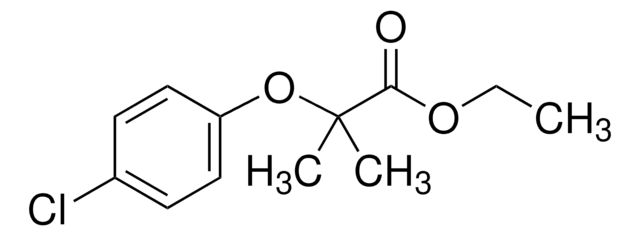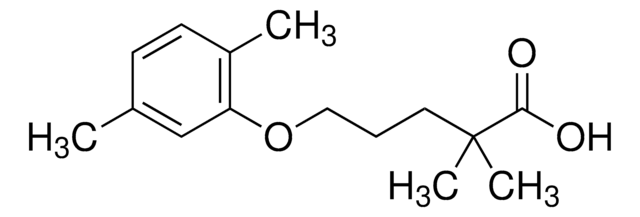C6643
Clofibrate
liquid
Sinónimos:
2-(4-Chlorophenoxy)-2-methylpropionic acid ethyl ester, Ethyl 2-(4-chlorophenoxy)-2-methylpropionate, Ethyl 2-(4-chlorophenoxy)isobutyrate
About This Item
Productos recomendados
form
liquid
color
clear colorless
density
1.14 g/mL at 25 °C (lit.)
originator
Wyeth
storage temp.
2-8°C
SMILES string
CCOC(=O)C(C)(C)Oc1ccc(Cl)cc1
InChI
1S/C12H15ClO3/c1-4-15-11(14)12(2,3)16-10-7-5-9(13)6-8-10/h5-8H,4H2,1-3H3
InChI key
KNHUKKLJHYUCFP-UHFFFAOYSA-N
Gene Information
human ... PPARA(5465)
mouse ... Ppara(19013)
¿Está buscando productos similares? Visita Guía de comparación de productos
Application
- as a quinolinate phosphoribosyltransferase (QPRT) agonist to study its effects on hepatitis C virus (HCV) infection
- as peroxisome proliferated activated receptor (PPAR) agonist to study its effects on autophagy in rat liver cells
- as a hepatotoxicant to study its effects on gene expression in primary rat hepatocytes
Biochem/physiol Actions
Features and Benefits
Packaging
signalword
Danger
hcodes
Hazard Classifications
Acute Tox. 4 Oral - Eye Dam. 1 - Skin Irrit. 2 - STOT SE 3
target_organs
Respiratory system
Storage Class
10 - Combustible liquids
wgk_germany
WGK 3
flash_point_f
235.4 °F - closed cup
flash_point_c
113 °C - closed cup
ppe
Eyeshields, Faceshields, Gloves, type ABEK (EN14387) respirator filter
Certificados de análisis (COA)
Busque Certificados de análisis (COA) introduciendo el número de lote del producto. Los números de lote se encuentran en la etiqueta del producto después de las palabras «Lot» o «Batch»
¿Ya tiene este producto?
Encuentre la documentación para los productos que ha comprado recientemente en la Biblioteca de documentos.
Los clientes también vieron
Artículos
Cholesterol synthesis regulation by dietary levels, LDL receptors control lipid-rich LDL particle transport in cells.
Discover Bioactive Small Molecules for Lipid Signaling Research
Nuestro equipo de científicos tiene experiencia en todas las áreas de investigación: Ciencias de la vida, Ciencia de los materiales, Síntesis química, Cromatografía, Analítica y muchas otras.
Póngase en contacto con el Servicio técnico
















